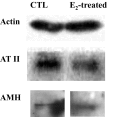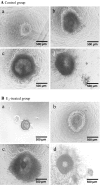Effects of Estradiol on the Paracrine Regulator Expression of In Vitro Maturated Murine Ovarian Follicles
- PMID: 30603459
- PMCID: PMC6171573
- DOI: 10.1007/s13770-016-0006-1
Effects of Estradiol on the Paracrine Regulator Expression of In Vitro Maturated Murine Ovarian Follicles
Abstract
The preservation of female germ cells is important in the individuals with ovarian dysfunction and failure. For this purpose, ovarian follicle in vitro maturation (OFIVM) is an important technology for the retrieval of mature oocytes. In the in vivo follicular development, paracrine factors such as angiotensin (AT) and anti-Müllerian hormone (AMH) play important roles. We attempted to add estrogen during the OFIVM and to assess their expression on the follicular cells. The ovaries and pre-antral follicles were collected from 13-day C57BL/6 mice and cultured in vitro with estradiol (E2) treatment for up to two weeks. In the whole ovaries, the expression of AT II was decreased and the expression of AMH was similar between control and E2-treated ovaries after in vitro culture. Although there was no difference in the survival, ovulation, maturation and fertilization rates between control and E2-treated groups, the expression of AT II in the follicular cells was down-regulated after E2 treatment at mRNA level, and AMH showed similar expression. In conclusion, adding E2 in OFIVM may regulate paracrine factors and their receptors that are related to follicular development. Further investigations are necessary to elucidate the roles of various sex hormones in the regulation of AT and AMH expression during the OFIVM.
Keywords: Angiotensin; Anti-Müllerian hormone; Estrogen; Ovary.
Conflict of interest statement
The authors have no conflicts of interest.The study was approved by the IACUC of the Seoul National University Hospital (IACUC no.15-0016-S1A0).
Figures






Similar articles
-
Matrix-free 3D culture supports human follicular development from the unilaminar to the antral stage in vitro yielding morphologically normal metaphase II oocytes.Hum Reprod. 2021 Apr 20;36(5):1326-1338. doi: 10.1093/humrep/deab003. Hum Reprod. 2021. PMID: 33681988 Free PMC article.
-
Anti-Müllerian hormone promotes pre-antral follicle growth, but inhibits antral follicle maturation and dominant follicle selection in primates.Hum Reprod. 2016 Jul;31(7):1522-30. doi: 10.1093/humrep/dew100. Epub 2016 May 9. Hum Reprod. 2016. PMID: 27165618 Free PMC article.
-
Direct actions of androgen, estrogen and anti-Müllerian hormone on primate secondary follicle development in the absence of FSH in vitro.Hum Reprod. 2017 Dec 1;32(12):2456-2464. doi: 10.1093/humrep/dex322. Hum Reprod. 2017. PMID: 29077845 Free PMC article.
-
Fibrin promotes development and function of macaque primary follicles during encapsulated three-dimensional culture.Hum Reprod. 2013 Aug;28(8):2187-200. doi: 10.1093/humrep/det093. Epub 2013 Apr 21. Hum Reprod. 2013. PMID: 23608357 Free PMC article.
-
Interactions between androgens, FSH, anti-Müllerian hormone and estradiol during folliculogenesis in the human normal and polycystic ovary.Hum Reprod Update. 2016 Nov;22(6):709-724. doi: 10.1093/humupd/dmw027. Epub 2016 Aug 27. Hum Reprod Update. 2016. PMID: 27566840 Review.
Cited by
-
Preservation of fertility in female and male prepubertal patients diagnosed with cancer.J Assist Reprod Genet. 2023 Dec;40(12):2755-2767. doi: 10.1007/s10815-023-02945-2. Epub 2023 Sep 29. J Assist Reprod Genet. 2023. PMID: 37770817 Free PMC article. Review.
-
Animal Models for Human Polycystic Ovary Syndrome (PCOS) Focused on the Use of Indirect Hormonal Perturbations: A Review of the Literature.Int J Mol Sci. 2019 Jun 3;20(11):2720. doi: 10.3390/ijms20112720. Int J Mol Sci. 2019. PMID: 31163591 Free PMC article. Review.
-
The expression profile of angiotensin system on thawed murine ovaries.Tissue Eng Regen Med. 2016 Dec 17;13(6):724-731. doi: 10.1007/s13770-016-0009-y. eCollection 2016 Dec. Tissue Eng Regen Med. 2016. PMID: 30603453 Free PMC article.
-
Profile of MicroRNA Expression in Endometrial Cell during In Vitro Culture According to Progesterone Concentration.Tissue Eng Regen Med. 2017 Sep 8;14(5):617-629. doi: 10.1007/s13770-017-0080-z. eCollection 2017 Oct. Tissue Eng Regen Med. 2017. PMID: 30603515 Free PMC article.
-
A comparison of the anti-diabetic potential of d-ribose-l-cysteine with insulin, and oral hypoglycaemic agents on pregnant rats.Toxicol Rep. 2018 Aug 9;5:832-838. doi: 10.1016/j.toxrep.2018.08.003. eCollection 2018. Toxicol Rep. 2018. PMID: 30140615 Free PMC article.
References
-
- Ata B, Zeng X, Son WY, Holzer H, Tan SL. Follicular synchronization using transdermal estradiol patch and GnRH antagonists in the luteal phase; does it increase oocyte yield in poor responders to gonadotropin stimulation for in vitro fertilization (IVF)? A comparative study with microdose flare-up protocol. Gynecol Endocrinol. 2011;27:876–879. doi: 10.3109/09513590.2011.569596. - DOI - PubMed
-
- Dragisic KG, Davis OK, Fasouliotis SJ, Rosenwaks Z. Use of a luteal estradiol patch and a gonadotropin-releasing hormone antagonist suppression protocol before gonadotropin stimulation for in vitro fertilization in poor responders. Fertil Steril. 2005;84:1023–1026. doi: 10.1016/j.fertnstert.2005.04.031. - DOI - PubMed
-
- Weitzman VN, Engmann L, DiLuigi A, Maier D, Nulsen J, Benadiva C. Comparison of luteal estradiol patch and gonadotropin-releasing hormone antagonist suppression protocol before gonadotropin stimulation versus microdose gonadotropin-releasing hormone agonist protocol for patients with a history of poor in vitro fertilization outcomes. Fertil Steril. 2009;92:226–230. doi: 10.1016/j.fertnstert.2008.04.024. - DOI - PubMed
-
- Huang N, Situ B, Chen X, Liu J, Yan P, Kang X, et al. Meta-analysis of estradiol for luteal phase support in in vitro fertilization/intracytoplasmic sperm injection. Fertil Steril. 2015;103(367–373):e365. - PubMed
-
- Fritz MA, Speroff L. Clinical gynecologic endocrinology and infertility. 8. Philadelphia: Wolters Kluwer Health/Lippincott Williams & Wilkins; 2011.
LinkOut - more resources
Full Text Sources
